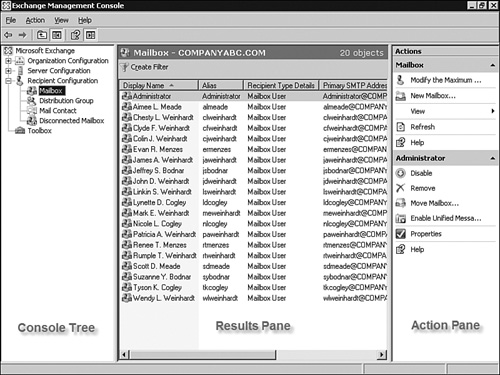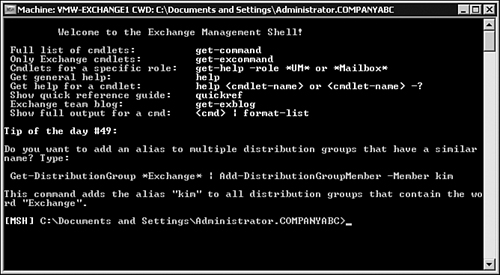Several new and improved tools are available to
administer and manage an Exchange Server 2007 environment. There are
Microsoft Management Console snap-ins, an automation and scripting
shell, and several tools native to the Windows Server 2003 operating
system and the Exchange Server 2007 application.
The Exchange Management Console
The Exchange Management Console shown in Figure 1 is one of the primary tools provided with Exchange Server 2007. This utility replaces the Exchange System Manager from Exchange 2000/2003 and can be used to manage Exchange Server 2007 and Exchange Server 2003 servers in the organization.

The
Exchange Management Console is a snap-in that is designed to work with
the new Microsoft Management Console (MMC) 3.0, a new and improved
version of the MMC. To install MMC 3.0 on a system, the system must be
running Microsoft Windows Server 2003 (SP1) or higher, or Microsoft
Windows XP (SP2) or higher. MMC 3.0 is included by default with
Microsoft Windows Server 2003 R2 and Microsoft Windows Vista.
Unlike
the Exchange System Manager, which allowed administrators to access all
configuration settings of their Exchange 2003 environment, the Exchange
Management Console is designed to allow administrators access to common
configuration settings from the familiar graphical user interface
(GUI). However, many aspects of the environment cannot be viewed or
modified with this utility. For such configuration settings, the
Exchange Management Shell, which is discussed next, must be used.
The Exchange Management Shell
The
second utility for managing an Exchange 2007 environment is a new
automation and scripting tool called the Exchange Management Shell,
shown in Figure 2. This shell is a command-line management interface that can be used to administer servers in an Exchange
2007 organization. Built on Microsoft Windows PowerShell technology
(formerly code-named “Monad”), the Exchange Management Shell can
perform any task that can be accomplished in the Exchange Management
Console, and a lot more. In fact, many configuration settings in an
Exchange 2007 environment can only be accomplished using the Exchange
Management Shell.

The
Exchange Management Shell can be installed on computers with a 32-bit
processor running Windows 2000, Windows Server 2003, Windows XP, and
Windows Vista.
Exchange Best Practices Analyzer
The
Exchange Best Practices Analyzer (ExBPA) is included in Exchange Server
2007 and can be found in the Exchange Management Console toolbox.
The
ExBPA can be used to run health checks on an Exchange environment, and
can also run performance checks, permissions checks, and connectivity
tests to assist when troubleshooting problems.
The
ExBPA should be run whenever a new server is added to an Exchange 2007
environment, or whenever configuration changes are made.
Disaster Recovery Tools
Also
included in the Exchange Management Console toolbox are two utilities
designed to analyze and maintain Exchange databases. The Database
Troubleshooter can inspect existing databases and available transaction
logs and report on any problems found. The tool also offers recommended
steps that should be taken to ensure the database is healthy.
The
Database Recovery Management utility is intended to assist
administrators when a database is unable to mount. This tool also
generates recommended step-by-step instructions to follow to bring the
database back online.
Mail Flow Tools
The
Mail Flow Troubleshooter is a utility that assists with troubleshooting
common mail flow issues in an Exchange environment. Administrators can
input the issues they are encountering, and the utility gathers
information, diagnoses the environment, and presents a recommended plan
of action.
The Message Tracking utility
allows administrators to search for messages and track them through the
Exchange environment. Message tracking can be extremely useful for
determining where a message was delayed or “stuck” in the messaging
environment.
The Mail Flow Troubleshooter
and the Message Tracking utility are both included in the Exchange
Server 2007 Exchange Management Console toolbox.
Exchange Queue Viewer
The
Exchange Queue Viewer is another utility included in the Exchange
Management Console toolbox that is added to an Exchange server when the
Hub Transport or Edge Transport role is installed. The Exchange Queue
Viewer is used to view the contents of the queues for each particular
protocol on a server. Although this tool is more of a troubleshooting
tool, it is important to periodically check protocol queues (for
example, SMTP or X.400 queues) to ensure that no delivery problems
exist.
Performance Tools
The
Exchange Management Console toolbox includes two tools that are
designed to monitor and troubleshoot performance issues in an Exchange
environment.
The Exchange Server
Performance Monitor is based on the Windows Performance Monitor, but
includes a series of predefined counters that are specifically related
to an Exchange environment.
The
Performance Troubleshooter is designed to help administrators identify
and locate performance issues that are impacting the Exchange
environment.